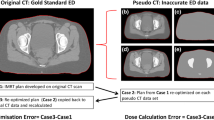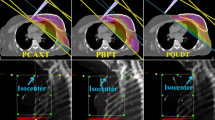Abstract
EPIgray is an in-vivo dosimetry system which uses electronic portal images to calculate dose delivered to a point of interest (POI) and the percentage dose difference (%DDiff) from expected dose. For 3D conformal radiotherapy (3DCRT) of breasts, a small shift between patient position on treatment compared to the planning CT is often clinically accepted. However due to the use of the planning CT in the EPIgray back-projection algorithm, acceptable shifts can have undue impact on EPIgray dose so it does not reflect true POI dose. At our centre ± 5.0% %DDiff tolerance is used for all treatment sites, however for breast treatments this effect causes false positive (FP) results, which may mean an actual treatment error is not detected. Patient position can be better represented within EPIgray using a contour correction (CC) method, increasing dose calculation accuracy. A custom breast-lung phantom was developed to validate use of CC, then EPIgray data of 30 breast patients were retrospectively analysed with CC. %DDiff before and after CC identified a FP rate. A process to determine optimal EPIgray tolerances for breast 3DCRT to reduce incidence of FP results is presented, based on analysis of factors influencing %DDiff and a receiver operator characteristic curve analysis of the retrospective study data. This process determined that a reduced tolerance of ± 3.5% would optimise utility of the EPIgray results, but this would require additional clinical resources to investigate the correspondingly increased rate of false negative results. Choice of tolerance requires consideration of workload and aims of the IVD program.



Similar content being viewed by others
References
International Atomic Energy Agency (2013) Development of procedures for in vivo dosimetry in radiotherapy. IAEA Human Health Report No. 8, IAEA.
Mijnheer B, Beddar S, Izewska J, Reft C (2013) In vivo dosimetry in external beam radiotherapy. Med Phys 40(7)
Antonuk LE (2002) Electronic portal imaging devices: a historical perspective of contemporary technologies and research. Phys Med Biol 47:R31–65
Boyer AL, Antonuk L, Fenster A, Herk MV, Meertens H, Munro P, Reinstein LE, Wong J (1992) A review of electronic portal imaging devices (EPIDs). Med Phys 19:1–16
Kirby MC, Glendinning AG (2006) Developments in electronic portal imaging systems. Br J Radiol 79:S50–65
Elmpt WV, McDermott L, Nijsten S, Wendling M, Lambin P, Mijnheer B (2008) A literature review of electronic portal imaging for radiotherapy dosimeter. Radiother Oncol 88:289–299
DOSIsoft (2013) EPIgray practical guide edition 2.0.3. DOSIsoft, Cachan
Francois P, Boissard P, Berger L, Mazal A (2011) In vivo dose verification from back projection of a transit dose measurement on the central axis of photon beams. Med Phys 27:1–10
Dupuis P, Ginestet C, Rousseau V, Kafrouin H (2011) In vivo Dosimetry using EPIgray software based on transit dosimetry for Elekta iViewGT electronic portal imaging. Physica Medica 27
Celi S, Costa E, Wessles C, Mazal A, Fourquet A, Francois P (2016) EPID-based in-vivo dosimetry clinical experience and results. J Appl Clin Med Phys 17:262–276
Elekta (2013) Monaco® user guide Monaco version 5.00.00, IMPAC Medical Systems.
Landberg T, Chavaudra J, Dobbs J, Hanks G, Johansson KA, Moller T, Purdy J (1993) ICRU Report 50 prescribing, recording and reporting photon beam therapy. J Int Comm Radiat Units Meas os26(1)
Elekta Limited (2010) iViewGT R3.02 - R3.4 corrective maintenance manual, Elekta.
Chang J, Mageras S, Chui CS, Ling C, Lutz W (2000) Relative profile and dose verficiation of intensity-modulated radiation therapy. Int J Rad Oncol Biol Phys 47
Venables K, Winfield E, Deighton A, Aird E, Hoskin P (2001) The start trial measurement in semi-anatomical breast and cell wall phantoms. Phys Med Biol 46:1937–1948
Davis JB, Miltchev V (1999) Tangential breast irradiation: a multi-centric intercomparison of dose using mailed phantom and thermoluminescent dosimetry. Radiother Oncol 52:65–68
Kalef-Ezara KT, Karantanas JA (1998) Electron density of tissues and breast cancer radiotherapy—a quantitative CT study. Int J Radiat Oncol Biol Phys 41:1209–1214
Cloutier RJ (1989) Tissue substitutes in radiation Dosimetry and measurement radiation research. Radiat Res 119(3):582–583
BIPM (2008) Evaluation of measurement data—guide to the expression of uncertainty in measurement. JCGM
Andreo P, Burns DT, Hohlfeld K, Huq MS, Kanai T, Laitano VS, Vynckier S (2006) Absorbed dose determination in external beam radiotherapy: an international code of practice for Dosimetry based on standards of absorbed dose to water, international atomic energy agency.
Hajian-Tilaki K (2013) Receiver operating characteristic (ROC) curve analysis for medical diagnosis test evaluation. Caspina J Int Med 4:627–635
Perkins N, Schistermann E (2005) The inconsistency of optimal cutpoints obtained using two criteria based on receiver operating characteristic curve. Am J Epidemiol 163:670–675
Greiner M, Pfeiffer D, Smith R (2000) Principlres and practical application of receiver operating characteristic analysis for diagnostic tests. Prev Vet Med 45:24–40
Hanley J, McNeil B (1982) The meaning and use of the area under a receiver operating characteristic curve. Radiology 143:29–36
Author information
Authors and Affiliations
Corresponding author
Ethics declarations
Conflict of interest
All authors declare that they have no conflict of interest.
Ethical approval
Any patient data used was anonymised, and used as part of a retrospective study only with no impact on the patient treatments, therefore ethics approval was not required.
Additional information
Publisher's Note
Springer Nature remains neutral with regard to jurisdictional claims in published maps and institutional affiliations.
Rights and permissions
About this article
Cite this article
Rajasekar, A., Moggré, A., Cousins, A. et al. Optimising the use of EPIgray for 3DCRT breast treatments. Phys Eng Sci Med 43, 1077–1085 (2020). https://doi.org/10.1007/s13246-020-00904-0
Received:
Accepted:
Published:
Issue Date:
DOI: https://doi.org/10.1007/s13246-020-00904-0




